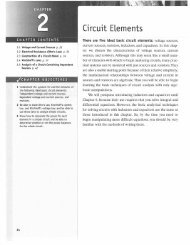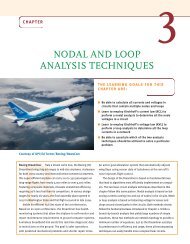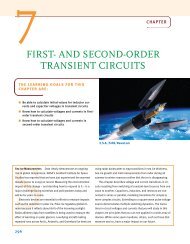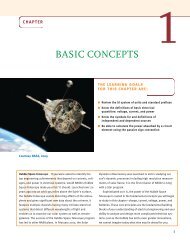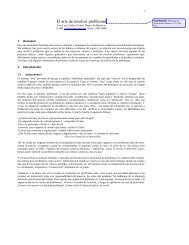Fundamentals of Electric Circuits
Fundamentals of Electric Circuits
Fundamentals of Electric Circuits
You also want an ePaper? Increase the reach of your titles
YUMPU automatically turns print PDFs into web optimized ePapers that Google loves.
3.9 Applications: DC Transistor <strong>Circuits</strong> 107<br />
Solution:<br />
The schematic is shown in Fig. 3.35. (The schematic in Fig. 3.35<br />
includes the output results, implying that it is the schematic displayed<br />
on the screen after the simulation.) Notice that the voltage-controlled<br />
voltage source E1 in Fig. 3.35 is connected so that its input is the<br />
voltage across the 4-<br />
resistor; its gain is set equal to 3. In order to<br />
display the required currents, we insert pseudocomponent IPROBES in<br />
the appropriate branches. The schematic is saved as exam311.sch and<br />
simulated by selecting Analysis/Simulate. The results are displayed on<br />
IPROBES as shown in Fig. 3.35 and saved in output file exam311.out.<br />
From the output file or the IPROBES, we obtain i 1 i 2 1.333 A and<br />
i 3 2.667 A.<br />
2<br />
R5<br />
E<br />
− +<br />
− +<br />
E1<br />
R1<br />
4<br />
+<br />
24 V V 1<br />
−<br />
1<br />
R6<br />
R2 2 R3 8 R4 4<br />
1.333E + 00 1.333E + 00 2.667E + 00<br />
0<br />
Figure 3.35<br />
The schematic <strong>of</strong> the circuit in Fig. 3.34.<br />
i 1 , i 2 , Practice Problem 3.11<br />
Use PSpice to determine currents and in the circuit <strong>of</strong> Fig. 3.36.<br />
i 3<br />
Answer: i 1 0.4286 A, i 2 2.286 A, i 3 2 A.<br />
3.9<br />
Applications: DC Transistor <strong>Circuits</strong><br />
Most <strong>of</strong> us deal with electronic products on a routine basis and have<br />
some experience with personal computers. A basic component for<br />
the integrated circuits found in these electronics and computers is the<br />
active, three-terminal device known as the transistor. Understanding<br />
the transistor is essential before an engineer can start an electronic circuit<br />
design.<br />
Figure 3.37 depicts various kinds <strong>of</strong> transistors commercially available.<br />
There are two basic types <strong>of</strong> transistors: bipolar junction transistors<br />
(BJTs) and field-effect transistors (FETs). Here, we consider only<br />
the BJTs, which were the first <strong>of</strong> the two and are still used today. Our<br />
objective is to present enough detail about the BJT to enable us to apply<br />
the techniques developed in this chapter to analyze dc transistor circuits.<br />
2 Ω<br />
10 V<br />
i 1<br />
+ −<br />
4 Ω<br />
2 A<br />
i 2<br />
i 3<br />
1 Ω i 1 2 Ω<br />
Figure 3.36<br />
For Practice Prob. 3.11.






